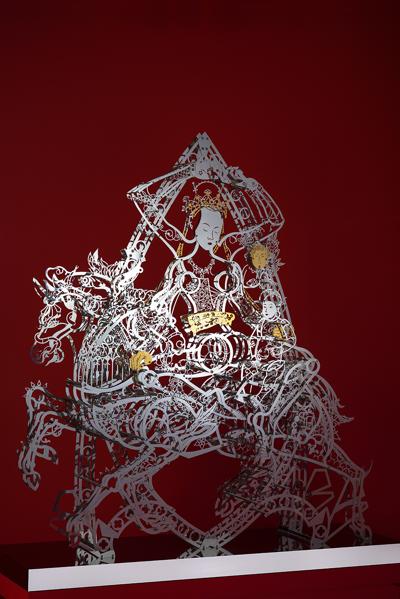
Plato’s Carriage of Soul is one of Taiwan artist Hsi Shih-pin’s metallic sculptures displayed at his first solo show in Beijing. [Photo provided to China Daily]
Hsi Shih-pin, a Taipei-based artist, uses metals and calculations in his sculptures to depict the universe in its many dimensions.
A typical project for him involves first designing the blueprint on the computer and then getting a factory to make the components of his design before putting them together in his studio. He usually creates six pieces a year.
Now on display in Beijing is Circus Maximus, his first solo show, with 13 sculptures.
“Everyone was designing buildings or making models, while I was fascinated by the metallic scraps left at a construction site near the campus,” he says of his time in college.
Although he started a degree in mathematics, Hsi switched to architecture within two years. He collected steel scraps from construction sites and produced his graduation piece.
He then pursued a master’s degree in sculpture from the Taipei National University of the Arts.
Hsi has studied the architecture of ancient Rome and the European Renaissance period.
“I was interested in the multiple roles of many artists during the two periods, who also worked as architects and extended their influence to the realm of theology,” he says, adding that he researched the works of Da Vinci and Michelangelo in particular.
In Plato’s Carriage of Soul, a 5-meter sculpture being presented at the Beijing show, Hsi visualizes the Greek philosopher’s Chariot Allegory.
His use of stainless steel with a coating of titanium plating makes his sculptures look both sharp and stiff. In his creations, animals such as the lion, tiger and bear, symbolize the male form.
He has also made many of his pieces pointed at the edges, a technique that both draws in and scares viewers of his work.

Plato’s Carriage of Soul is one of Taiwan artist Hsi Shih-pin’s metallic sculptures displayed at his first solo show in Beijing. [Photo provided to China Daily]
The artist associates the use of sharp angles to the tailoring job of his mother. He grew up watching his mother work with scissors and clothing clips.
He softens the coldness of steel by adding pendent artificial crystals and refined, exquisite patterns of flowers. Underneath the rationality of his works, Hsi instills the tenderness of family bond to reveal his emotional side.
Hsi pays respect to his mother in Holy Mother, another work on display. He created a figure half based on Mother Mary, inspired by the early Renaissance paintings and half based on Palden Lhamo, a wrathful deity in Tibetan Buddhism.
“My mother suffers from facial nerve disorders-she isn’t able to control half of her face. She’s become very nervous. She has been trying both Western medical treatments and traditional Chinese medicines. Yet, I think her face hasn’t change much and still looks pretty. I keep telling her that,” he says.
He adds that to a child, his or her mother’s look is free from the common perceptions of Oriental or Western aesthetics.
Hsi says that in real life, he doesn’t live like an artist. He likes to stay at home, raising his two cats and watching science or history shows on TV.
“Sometimes you need logical thinking like that of a mathematician,” he says of being a contemporary artist.
“When you work on a public art project, you need to work and think like an architect.”
If you go
10 am-6:30 pm, closed on Sundays and Mondays, through April 19. Soka Art Center, 798 art district, 2 Jiuxianqiao Road, Chaoyang district. 010-5978-4808.
